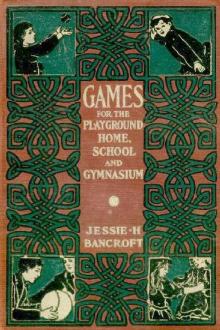Games for the Playground, Home, School and Gymnasium by Jessie Hubbell Bancroft (top novels of all time .txt) 📕

- Author: Jessie Hubbell Bancroft
- Performer: -
Book online «Games for the Playground, Home, School and Gymnasium by Jessie Hubbell Bancroft (top novels of all time .txt) 📕». Author Jessie Hubbell Bancroft
For an athletic contest for adults, the following rules are typical:—There should be eight potatoes for each team, placed two yards apart, the first potato two yards from the receptacle. The receptacle should be either a pail, basket, box, or can, not over two feet in height, having an opening not over thirty-six inches in circumference. The finish line is a "tape" (strand of worsted) stretched parallel with the starting line and five yards back of the receptacle. There should be a judge of fouls for each team and two judges at finish. Fouls are:—
1. Not placing a potato accurately on the spot.
2. Leaving a potato outside the receptacle instead of in it, whether it be dropped there or bound out.
3. Starting over the line without or before the "touch off."
A foul corrected before the next step in the game be taken does not score as a foul. The teams win first, second, third, and fourth places in the order of finishing, if there be no fouls. Where fouls have been scored, the team finishing first, with the fewest number of fouls, has first place, etc. In case of a tie, the tied teams must play again to determine the winner.
20 to 100 players.
Playground; gymnasium; seashore.
This first description is for an informal game. This is followed by rules for an athletic contest.
This is a form of potato race suitable for large numbers. The ground is marked off with two starting lines, one at either end of the ground. At even intervals between these two lines a row of from four to ten spots should be clearly marked on the ground, each row forming a line at right angles to the starting lines. There should be as many rows of this kind as there are teams.
On the first spot of each row should be placed a box, basket, or pail, and in it three or more potatoes, according to the number of spots. Stones may be used, blocks of wood, or any other uniform objects as a substitute for potatoes, but the latter are best.
The players are divided into two or more equal groups, and each group is subdivided as for a shuttle relay into two divisions. One division of each group stands in single file behind the starting line at one end of the ground, the other division facing it in single file behind the opposite starting line. Between the two divisions should stretch the row of spots. The receptacle should be on the spot near the first runner.
At a signal, the first runner of each team starts over the line, takes a potato from the box, places it on the first spot, returns, gets another potato, places it on another spot, and so on until all are placed; he need not observe strictly the consecutive order of the spots. He then runs forward and touches the outstretched hand of the first runner in the opposite file of his team. This runner must pick up the potatoes and replace them in the box one at a time, and then "touch off" the player facing him in the opposite file. Each player, as he finishes his part ("touches off" the next runner), should leave the running space entirely and not line up with his team. The line nearest the box serves as a finish line, and the team wins whose last runner, having replaced the last potato, is first to get over this line.
If a potato be dropped, the runner must pick it up and replace it in the box or on the spot, then make his play over again.
The above description is for a comparatively informal game. For a strict athletic contest for junior players the following rules, used by the Girls' Branch of the Public Schools Athletic League, New York City, are given:—
The laying out of the grounds should be for four spots in each row, two yards between each, with the starting lines two yards back of the first and fourth spots. The receptacle is placed on the spot nearest the first runners, and should be a pail, basket, box, or can, not over twenty-four inches in circumference at the opening. Three potatoes are used.
The first runners start on signals, "On your marks!" "Get set!" (or "Get ready!") "Go!" There should be a judge to score fouls for each division of each team, and two judges at the finish.
In case of a tie, the tied teams play again.
Fouls consist in: 1. Placing a potato otherwise than on the mark. 2. Leaving a potato outside the receptacle instead of in it, whether it be dropped outside or bound out. 3. Starting over the line without the "touch off." Any foul corrected before going on with the next step in the game does not score as a foul. Teams win in the order of finishing, plus consideration of the record on fouls. Thus, a team finishing fourth, with no fouls, would get first place, if the teams finishing first, second, and third all had fouls.
6 to 60 players.
Parlor; playground; gymnasium.
This is a form of potato race that may afford much amusement, especially for indoor companies. The players are divided into two or more groups which compete against each other. Each group lines up in single file, so that the leaders all toe a starting line. Placed on the floor in front of each group, and stretching ahead in the same direction, should be a row of potatoes at intervals of two or three feet apart, one for each player in the file. The larger and the more irregular in shape the potatoes the better. There should be from six to ten potatoes for each row. Each leader should be furnished with a teaspoon, and beside the leader of each file should be a pan, box, or basket, in which the potatoes are to be placed. At a signal each leader starts forward, takes up a potato on the spoon, carries it to the box or basket beside his first standing position, and places the potato in it; he then hands the spoon to the next player, and passes off the playing field, not lining up again with his team. The second player picks up the next potato, puts it in the box, and so on, until all have played, the last one standing beside the box with the spoon held aloft as a signal that he has finished.
It is not allowable to touch the potato with anything but the spoon. Should a potato be touched otherwise, the player must replace it and pick it up again on the spoon. Should a potato drop from the spoon, it must be picked up on the spoon where it dropped, and the play continued from that point.
PRISONER'S BASEPrisoner's Base is one of the most popular games for both boys and girls who are beginning to care for team organization, and is capital for adults. It gives opportunity for vigorous exercise for all of the players, for the use of much judgment, prowess, and daring, and for simple team or coöperative work.
The game is found under many different forms. Several, which offer marked or typical differences, each possessing distinct playing values, are given here. These differences are in (1) the arrangement of the ground, and (2) the rules governing the players and game.
The differences in the grounds may be classed as follows:—
I. The entire playground divided in two divisions, one belonging to each party, each division having a small pen for prisoners at the rear. (Diagram I.)
II. The main part of playground neutral territory, with home goals for the opposing parties at opposite ends, with prisons in, near, or attached to them. (Diagrams II, V.)
III. The main part of playground neutral territory, with home goals for both parties at the same end, attached or separate, and prisons at the opposite end, either (1) on the same side of the ground as the home goal, or (2) on the enemy's side of the ground. (Diagrams III-IV.)
The rules for play for the second and third types of ground are fundamentally the same, though differing in details, and they differ from those for Diagram I. The playing qualities of the games for the last three diagrams, however, are very distinct because of the different methods of the enemies' approach to each other (which make differences in the risk of "dares"), and because of the differing risks in rescuing prisoners and taking the enemy's goal by entry.
It has seemed best to make a selection of the typical forms, and leave the leader of games free to choose his own. The first form is the simplest for beginners and younger players, and makes a good introduction to the game for such players.
Stealing Sticks is still another form of Prisoner's Base. The main difference lies in the carrying away of the enemy's property.
Prisoner's Base and related games are supposed to have descended from the days of border warfare. They are very old, and Strutt mentions a "Proclamation at the head of the Parliamentary proceedings early in the reign of Edward the Third, ... where it [Prisoner's Base] is prohibited in the avenues of the palace at Westminster during the sessions of Parliament, because of the interruption it occasioned to the members and others in passing to and fro." The game at that time was played by adults.
PRISONER'S BASE—I10 to 30 or more players.
Playground; gymnasium.
The ground is divided into two equal parts, with a small base or prison marked off at the farther end of each division. From five to fifteen players guard each side. They venture into the enemy's ground, and, if caught, are put into the prison, where they must remain until tagged by one of their own side who is free. Both prisoner and rescuer may be tagged and brought back to prison before reaching their own ground. The game is won when one side makes prisoners of all of its opponents, or when a free man enters the opponents' prison, but this last may be done only when there are no prisoners there.
This form of Prisoner's Base differs from others in greater simplicity, both as to the arrangement of the ground and the rules of play. It is therefore better for younger players or beginners in the game.
The differences in detail consist in:—
1. The ground being divided by a line through the center into two opposing territories. In other forms, the main playground is neutral territory, each party having a small home goal marked within it.
2. In this game (No. I) a player cannot





Comments (0)